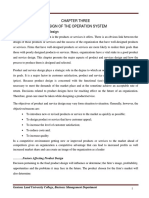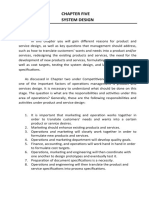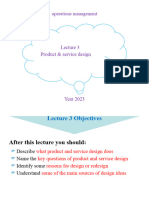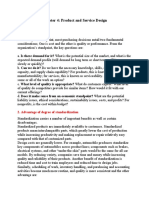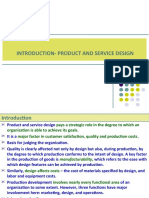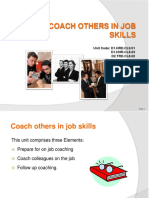Chapter 4 - Product and Service Design
Uploaded by
CJ De LunaChapter 4 - Product and Service Design
Uploaded by
CJ De LunaChapter 4 - Product And Service Design
Summary:
When planning on producing a new product and/or service, the key factor is the product and service
design. Successful designs come down to these basic principles: translate customers' wants and
needs, refine existing products and services, develop new products and services, formulate
quality goals, formulate cost targets, construct and test prototypes, document specifications, and
translate products and service specification into process specifications. The process of design has
certain steps that include motivation, ideas for improvement, organizational capabilities, and forecasting.
In the product process innovations, research and development play a significant role. Because of the
influence a product and service design can have on an organization, the design process is encouraged to
be tied in with the organization's strategy and take into account some key considerations.
Technological changes, the competitive market, and economic and demographic changes are some
market opportunities and threats that all organizations must be aware of when planning a product and
service design. Computer-aided design (CAD) and Computer-aided manufacturing (CAM) are
important tools in the design process because they can anticipate what the design will look like, as well as
allow for better manufacturing. Businesses also must take in account environmental and legal concerns
when designing a new product. Most importantly, the manufacturing process must ensure the product's
safety.
Product and Service Design
Companies choose various ways to design their products and the type of services they provide. Which
include: standardization, mass customization, delayed differentiation, modular design, and robust
design. Deciding which method to use is very important along with deciding the company's target market.
Deciding the right method, establishes good productivity and efficient way fo operations.
Service design is an activity of organizing and planning people, communication and material
components in order to improve service quality. It is the interaction between the service provider and
customers and the customers' experience. A service is anything that is done to or for a client and is
created and delivered simultaneously. The two most important issues in service design are the degree of
variation in requirements and the degree of customer contact in which determines how standardized
the service can be. The greater the degree of customer contact, the greater the opportunity for selling. In
addition, concepts and ideas generated are captured in sketches or in service prototypes. The strong
visual element, combined with the opportunity to test and rapidly change services and interfaces, delivers
real value in today's competitive markets.
Product Design combines ergonomics with product and business knowledge to generate ideas and
concepts and convert them into physical and usable objects or services. The discipline covers the entire
range of activities from concept, manufacturing, testing to product launch. Product Designers
conceptualize and evaluate ideas and themes they find profitable. The designers make these ideas
tangible through products using a systematic approach.
Difference between service design and product design: Service design is an intangible aspect while
product design is tangible. Services are generally created and delivered at the same time and can not be
held in inventory like actual products. Also, services (especially quality one) are highly visible to
customers.
Product and Service Life Cycle
During their useful life, many services and products go through four stages. Since the demand can vary
for each of these 4 stages, different strategies should be applied to achieve optimum product/service
performance during each stage.
The Four stages are:
1. Introduction: During the first stage, the product is introduced into the market. Proper research and
forecasting should be done to ensure the product/service is adequate for a specific market and for a
specific time. It is crucial to have a proper amount of supply that can meet the expected demand for the
product/service.
2. Growth: The second stage involves the increase in demand for the product/service. Reputation for the
product grows and an accurate forecast of demand is needed to determine the length of time the
product/service will remain in the market. Enhancements and improvements are common in this stage.
3. Maturity: This third stage deals with the product reaching a steady demand. Few or no improvements
or product changes are needed at this stage. Forecasting should provide an estimate of how long it will
be before the market dies down, causing the product to die out.
4. Decline: The last stage involves choosing to discontinue the product/service, replacing the product
with a new product, or finding new uses for the product.
Standardization may be great for a company creating products like mops because there are not many
things you can do to make them unique and keep the price down. Standardization products have
interchangeable parts, which increases productivity and lowers the costs of production. Standardization
has many important benefits and certain disadvantages. Some advantages are the design costs for
standardization products are low. The scheduling of work inventory handling, purchasing, and accounting
activities are routine, making the quality more consistent. The disadvantages with standardization are that
they decrease variety offered to consumers leading to less of an appeal. Also, the high cost of design
change makes it relentless to improve.
Mass customization is a strategy that some companies can use to incorporate customization while
practicing standardization. This strategy keeps costs low while adding variety to a product. The two
tactics that make mass customization possible is delayed differentiation and modular design. Some
companies may consider delayed differentiation if the company chooses to not finish a product due to
unknown customer preferences. However, another tactic of modular design is a form of standardization in
which components' parts are grouped into modules to allow easy replacement or interchangeability.
Producing a computer is an example of modular design.
Companies will also have to consider what their competitors are doing in order to be successful. There
are 3 ways of idea generation: supply based, competitor based, and research based. Which ever a
company chooses, they must consider who is competing against them and what else is going on in the
marketplace. Product design is key to the success of the company.
Customer Satisfaction and Sustainability
Product and service design are very important factors to customer satisfaction. Organizations need to
continually satisfy their customers to be successful in the marketplace. They are able to do this by
improving current products or by designing new ones. The design consists of the following: research,
design, production, life cycle, safety in use, reliability, maintainability, regulatory and legal issues.
Organizations also need to look at "sustainability" when designing their product/service.
The four aspects of Sustainability are:
(1) Life Cycle Assessment
(2) Value Analysis
(3) Remanufacturing
(4) Recycling.
Life cycle assessment focuses on the environmental impact the specific product will have over the
course of its life. Value analysis looks at the parts within a product and seeks to minimize the
cost. Remanufacturing has become more important over the past few years and involves replacing
worn-out and defective products. This is common practice in high price machinery
industries. Recycling involves recovering older materials for future use. This not only saves money, but
satisfies environmental concerns. The Kano Model includes three aspects: Basic quality, performance
quality, and excitement quality. Basic quality is the requirements placed on a product that do not lead to
customer satisfaction when present, but can lead to dissatisfaction if absent. Performance quality is the
middle ground and can either lead to satisfaction or dissatisfaction depending on their
usefulness. Excitement quality is the notion that an unexpected feature can cause customer excitement.
Reliability
Reliability is a measure of the ability of a product, a part, or service, or an entire system to perform its
intended function under a prescribed set of conditions. Reliability can have an impact on repeat sales and
reflect positively on a products image. However, if the product is faulty, it can create legal problems. The
term "failure" is used to describe a situation in which an item does not perform as intended. Reliabilities
are always specified with respect to certain conditions, called normal operating conditions. These
conditions can include load, temperature, and humidity ranges in addition to operating procedures and
maintenance schedules. To improve reliability, manufacturers should improve the reliability of individual
components or use back up components. A few other suggestions include improving testing, improving
user education, and improving system design. The optimal level of reliability is the point where the
incremental benefit received equals the incremental cost.
Legal and Ethical Consideration
Many organizations are regulated by governmental agencies and these regulations are responsible for
preventing harmful substances from being used in product design. Harm caused by the product is the
responsibility of the manufacturers. Manufacturers are liable for any injury or damages caused by their
product due to its design or workmanship, also known as product liability. When the product is defective
and potentially causes harm, manufacturers have several options to remedy the situation. They may have
to recall their products or fix the problem in the manufacturing stage. It is also possible that they may face
lawsuits if their products cause injury to consumers. Managers must ask themselves if there is demand
for their organizations product or service. If the company develops its products or services according to
the customers demands, their product will be successful.
You might also like
- Product and Service Design Operations Management100% (2)Product and Service Design Operations Management13 pages
- Chapter 4 Handouts Product and Service DesignNo ratings yetChapter 4 Handouts Product and Service Design8 pages
- OPERATIONS MANAGEMENT NOTES & REVIEWER (Midterm 1st Sem)No ratings yetOPERATIONS MANAGEMENT NOTES & REVIEWER (Midterm 1st Sem)11 pages
- The Increasing Importance of Product DesignNo ratings yetThe Increasing Importance of Product Design7 pages
- Manufacture Product Design and Process SelectionNo ratings yetManufacture Product Design and Process Selection23 pages
- Unit 3 - Design of The Operation System Part One.No ratings yetUnit 3 - Design of The Operation System Part One.32 pages
- MNGT3108 - M5-Product and Service DesignNo ratings yetMNGT3108 - M5-Product and Service Design7 pages
- Chapter Two Design of The Operations/production Systems 2.1. Product-Service Design and DevelopmentNo ratings yetChapter Two Design of The Operations/production Systems 2.1. Product-Service Design and Development42 pages
- Chapter Two Design of The Operations/production Systems 2.1. Product-Service Design and DevelopmentNo ratings yetChapter Two Design of The Operations/production Systems 2.1. Product-Service Design and Development46 pages
- What Does Product Service and Design Do?No ratings yetWhat Does Product Service and Design Do?6 pages
- OM Lecture 3 Product and Service DesignNo ratings yetOM Lecture 3 Product and Service Design26 pages
- Operations MGMT Lecture Note (Chapter 3) MLTNo ratings yetOperations MGMT Lecture Note (Chapter 3) MLT42 pages
- Chapter 4: Product and Service Design: 1. Key QuestionNo ratings yetChapter 4: Product and Service Design: 1. Key Question5 pages
- Module 3 - PPT -Operation Management TQM - P1No ratings yetModule 3 - PPT -Operation Management TQM - P159 pages
- Module 3 - PPT - Operation Management TQMNo ratings yetModule 3 - PPT - Operation Management TQM57 pages
- New Product Development Essentials: Hands-on Help for Small Manufacturers and Smart Technical People: No Nonsence Manuals, #2From EverandNew Product Development Essentials: Hands-on Help for Small Manufacturers and Smart Technical People: No Nonsence Manuals, #24/5 (1)
- How to Enhance Productivity Under Cost Control, Quality Control as Well as Time, in a Private or Public OrganizationFrom EverandHow to Enhance Productivity Under Cost Control, Quality Control as Well as Time, in a Private or Public OrganizationNo ratings yet
- De Luna, C-Jay W.: - 09564119356 Brgy. Lagalag, Tiaong, Quezon Philippines 4325No ratings yetDe Luna, C-Jay W.: - 09564119356 Brgy. Lagalag, Tiaong, Quezon Philippines 43253 pages
- The Effect of Credit Management On The Financial Performance of The Selected Microfinance Institutions in Candelaria100% (1)The Effect of Credit Management On The Financial Performance of The Selected Microfinance Institutions in Candelaria16 pages
- Other Credit Transactions: Davidson, Knowles & Forsythe Ed.)No ratings yetOther Credit Transactions: Davidson, Knowles & Forsythe Ed.)16 pages
- My Whole Tuition Was The Most Selected Reason of The Participants Because MostNo ratings yetMy Whole Tuition Was The Most Selected Reason of The Participants Because Most3 pages
- Evaluation of Subjects and Units Window D: NEW Student Including TransfereeNo ratings yetEvaluation of Subjects and Units Window D: NEW Student Including Transferee1 page
- Crate Conditioning of Bongo (Tragelaphus Eurycerus) For Veterinary and Husbandry Procedures at The Denver Zoological GardensNo ratings yetCrate Conditioning of Bongo (Tragelaphus Eurycerus) For Veterinary and Husbandry Procedures at The Denver Zoological Gardens8 pages
- Issues in Teacher Leadership Review - Phlong PaulinaNo ratings yetIssues in Teacher Leadership Review - Phlong Paulina2 pages
- Complete The Sentences With The Correct Form of The Words in Capitals!No ratings yetComplete The Sentences With The Correct Form of The Words in Capitals!4 pages
- Can LLMs Generate Architectural Design DecisionsNo ratings yetCan LLMs Generate Architectural Design Decisions11 pages
- KAS - 2020 Prelims - Gs - 1 (Foresightkas)No ratings yetKAS - 2020 Prelims - Gs - 1 (Foresightkas)20 pages
- GS 08 50208 SMDS Wax Plant Expansion PPD RevB1 PDFNo ratings yetGS 08 50208 SMDS Wax Plant Expansion PPD RevB1 PDF28 pages
- Mugomba-RegionalOrganisationsAfrican-1978No ratings yetMugomba-RegionalOrganisationsAfrican-197813 pages













